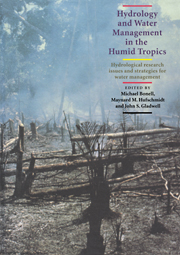 Hydrology and Water Management in the Humid Tropics
Hydrology and Water Management in the Humid Tropics Book contents
- Frontmatter
- Contents
- List of Authors
- Foreword by Federico Mayor, Director-General, UNESCO
- Preface
- Cartographic Credit
- Acknowledgements
- SECTION I INTRODUCTION
- SECTION II HUMID TROPICS SETTING
- SECTION III REGIONAL HYDROLOGY
- SECTION IV PHYSICAL PROCESSES
- SECTION V PHYSICAL PROCESSES – HUMAN USES: THE INTERFACE
- 17 Challenges in Agriculture and Forest Hydrology in the Humid Tropics
- 18 The Impact of Land-Use Change on Water Resources in the Tropics: An Australian View of the Scientific Issues
- 19 Urban Water Management Problems in the Humid Tropics: Some Technical and Non-Technical Considerations
- 20 The Management of Water Resources, Development and Human Health in the Humid Tropics
- 21 Water Supply and Health in the Humid Tropics with Particular Reference to Rural Areas
- SECTION VI MANAGEMENT ISSUES
- SECTION VII APPENDICES
- Place index
19 - Urban Water Management Problems in the Humid Tropics: Some Technical and Non-Technical Considerations
Published online by Cambridge University Press: 23 December 2009
- Frontmatter
- Contents
- List of Authors
- Foreword by Federico Mayor, Director-General, UNESCO
- Preface
- Cartographic Credit
- Acknowledgements
- SECTION I INTRODUCTION
- SECTION II HUMID TROPICS SETTING
- SECTION III REGIONAL HYDROLOGY
- SECTION IV PHYSICAL PROCESSES
- SECTION V PHYSICAL PROCESSES – HUMAN USES: THE INTERFACE
- 17 Challenges in Agriculture and Forest Hydrology in the Humid Tropics
- 18 The Impact of Land-Use Change on Water Resources in the Tropics: An Australian View of the Scientific Issues
- 19 Urban Water Management Problems in the Humid Tropics: Some Technical and Non-Technical Considerations
- 20 The Management of Water Resources, Development and Human Health in the Humid Tropics
- 21 Water Supply and Health in the Humid Tropics with Particular Reference to Rural Areas
- SECTION VI MANAGEMENT ISSUES
- SECTION VII APPENDICES
- Place index
Summary
ABSTRACT
This chapter reviews the present situation within the humid tropics with respect to urban sanitation, drainage, disaster preparedness, health, and water supply. It stresses the point that urban water management requires a broad perspective of the impacts. It discusses the technical and non-technical aspects that are both causing the problems and are necessary for their solution. It reviews briefly some of the approaches available to the urban water experts who will be presenting solutions.
INTRODUCTION TO URBAN WATER MANAGEMENT
The theory
The rapid growth of population centers in the tropics continues, and the various resources required by the populations put ever-greater demands upon the environment. It seems clear that the growth must have its limits. Yet it is difficult to see at the moment, at least, any concerted effort to stop the deterioration of the landscape that is already obvious. The problem also is by no means limited to those urbanizing areas of the developing countries, with the concept of “bankruptcy” now being extended, in theory at least for the moment, to several cities in well-developed countries. The problems of maintaining, let alone improving, the infrastructures of these cities for the management of their water resources is of ever-increasing concern.
But, while the pressures of increased population create increased problems, the cities do offer some of the solutions. Because, as difficult (some would say impossible) as the situation appears, cities provide answers. As noted by Lugo (1991), “ … when human activity is concentrated, human needs are easier to satisfy, human environmental impacts are easier to manage, and the standard of living and quality of life are easier to improve.
- Type
- Chapter
- Information
- Hydrology and Water Management in the Humid TropicsHydrological Research Issues and Strategies for Water Management, pp. 414 - 436Publisher: Cambridge University PressPrint publication year: 1993
